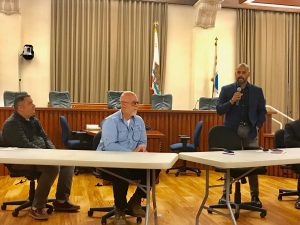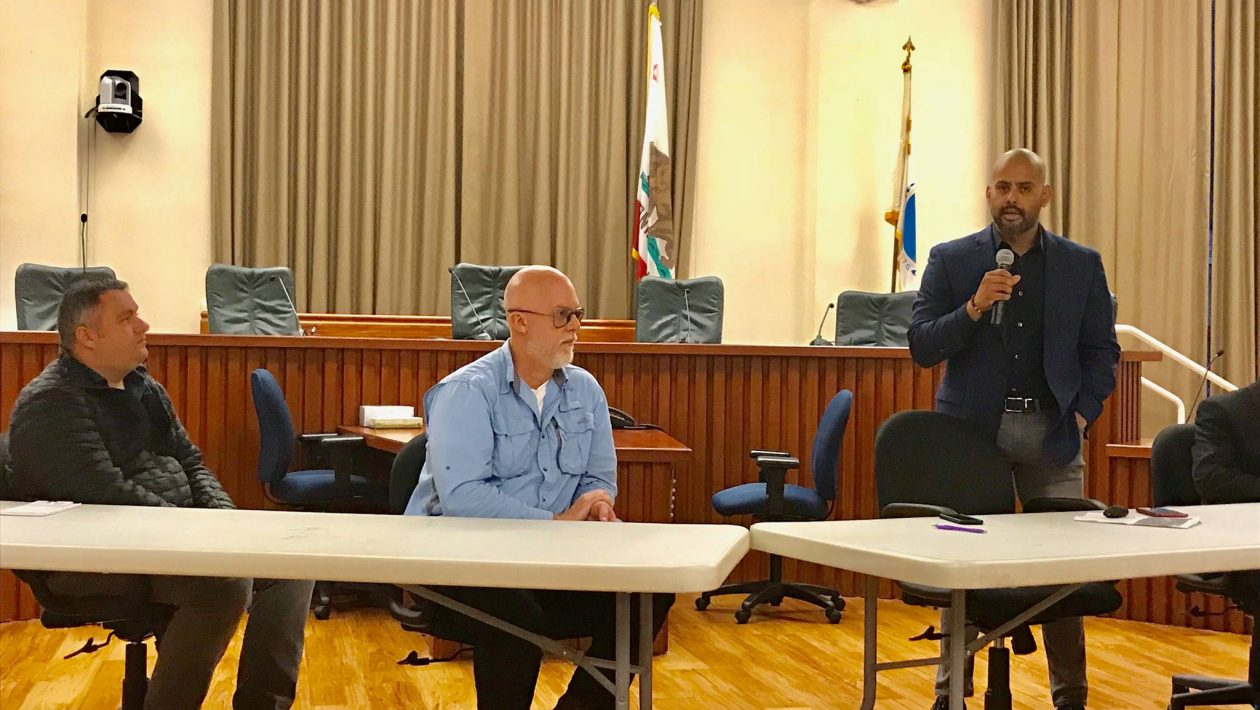
MARTINEZ, Calif. – While it’s inevitable that freight trains will block the two Martinez downtown crossings, the Union Pacific Railroad has taken measures to reduce the time motorists and pedestrians must wait for those trains to pass, officials said during a town hall meeting at Martinez City Hall.
Martinez Police Chief Manjit Sappal, whose office receives and records train-blocking complaints, was joined by Francisco Castillo, Union Pacific’s Northern California senior director of public affairs, and Carl Nagy and Dave Sperow, the incoming and outgoing managers of terminal operations at its Ozol Yard on Carquinez Scenic Drive, where longer trains are reconfigured through switching.
Union Pacific, a railroad company with 32,100 miles of rail in 23 states, has about 10,000 customers. Defined as a “common carrier,” it is required by federal law to haul any commodity packaged correctly by its customers, Castillo explained.
Sappal added, “The Federal government preempts state law regarding interstate commerce. It’s the environment we work in.”
The company carries a wide variety of goods.
“Anything and everything you touch, eat or drink” likely was carried by train before it reaches the private consumer, Castillo said. That includes vehicles, electrical equipment, chemical products, retail goods “and everything in between.”
Because they’re engaged in interstate commerce, railroads are governed by the Federal Railroad Administration, an agency in the United States Department of Transportation that oversees most freight and passenger rail operations excepts for closed railroads that operate solely on private property.
At times, federal regulation has frustrated local communities that have worried about such topics as transported crude and train noise.
Then there problems when trains block street crossings, the topic of Tuesday’s town hall that was organized with the help of U.S. Rep. Mike Thompson’s office.
Union Pacific tracks that pass in front of the Martinez Amtrak Station have the most traffic of any non-commuter area in Northern California, according to railroad aficionados.
Amtrak trains account for 30 of those trains, 15 from each of the two directions. Union Pacific Railroad (UPRR) has five local trains, two mainline trains and possibly others.
Castillo didn’t have Martinez’s exact daily counts of the freight and Amtrak trains, because while passenger trains follow regular schedules, freight trains depend on customer contracts. Freight companies don’t publish their customers’ train schedules.
However, rough counts indicate the number can range from 35 to nearly 50 a day, although some of these can be the same trains going back and forth.
Many of the freights come from the J.R. Davis Yard in Roseville, the largest railroad yard on the West Coast, Castillo said.
Covering 915 acres and having a 6,500 rail-car capacity, the Davis yard has two main lines, 55 curved “bowl” tracks, 5 miles of track built in its local area and more than 86 miles of new track as well as a repair plant.
Long manifest trains – those hauling a variety of products – travel to the Ozol yard, where the cars and locomotives are rearranged – sorted through switching into smaller, individual trains that serve Bay Area refineries and other destinations and customers.
Compared to the Davis Yard, Ozol is a small “choke” yard, said Sperow, who has spent the final five years of his career there. He’s retiring and is about to hand over its management to Nagy.
Sometimes people see a train of railroad cars go back and forth. That’s the yard’s switching operations, Sperow said. It can take up to 15 minutes to complete. “I get caught, too. But there’s a purpose,” he said.
After the cars are sorted and linked to locomotives, those newly-assembled trains go to various Bay Area cities, to refineries and to such industries as C&H Sugar and Eco Services.
Other delays Martinez motorists and pedestrians experience are caused by the length of freight trains coming from Roseville to Ozol, he said.
Those trains can’t simply slip past the city’s downtown crossings – they must wait for permission to proceed into the yard.
If a locomotive needs to be removed from a long train out of Roseville, it can take a half-hour to complete.
“We have to do our jobs,” he said, adding that his employees “are very professional folks.”
But Union Pacific also is striving to be a good neighbor, Castillo said.
Rather than tie up the tracks while pulling out a locomotive, the company is taking the unusual approach of sending it on, to be returned later. The locomotive may travel all the way to Oakland before it or another is sent back to Martinez.
Other train assembly is being done at night, to minimize interfering with daytime vehicle traffic.
But it’s not just to keep motorized traffic flowing, Sperow said. It’s also for safety.
“Safety of the community is our primary important goal,” he said. And his concern is for motorists who try to beat out a train as well as pedestrians, especially children, who attempt to cross the tracks midway through a train.
“We don’t want to block crossings,” he said.
But according to statistics accumulated by Martinez Police and provided to the railroad, blocking the downtown’s two crossings have drawn plenty of complaints.
One woman who said she lives aboard a boat at the Martinez Marina said she was among those who have complained after she had to wait at a crossing for 40 minutes.
Sappal’s report, given by Castillo, lists complaints from the September of one year to the next.
In 2013-14, police received 68 complaints of blocking of Berrellesa and Ferry streets’ crossings. That dropped to 32 in 2014-15. Th 2015-16 complaints reached 53 and dropped to 39 in 2016-17.
But from Sept. 2017-18, the department received 73 calls about trains blocking traffic.
Thompson helped Martinez representatives meet with UPRR Sept. 18, 2018, to address those complaints.
Part of the blockages involved construction and the closure of a bypass road. At other times, the railroad suffered mechanical failures. Another complication involves labor organization agreements that specify start and end times for shifts.
While the railroad representatives and Sappal said the situation can’t be eliminated, UPRR has incorporated changes to reduce the number or lengths of blockages, including night switching and sending locomotives on ahead.
Splitting a train at a crossing to let cars pass isn’t a good option, Sperow said.
“It’s time-consuming.” Cutting a train involves tying down the train with hand brakes. “It’s easier to give the train a route” – a way to get through or around the yard, he said.
Nagy said another problem with cutting a train or leaving cars tied down is they can’t get moved until a locomotive is attached, and that just adds to delays.
The Davis Yard is being asked to put the manifest set-out cars for the Ozol yard at the head of those trains. Some pressure has been relieved with the reopening of the bypass road that can give traffic an option during train switching.
Initial numbers indicate those changes are helping. From Oct. 1, 2018, through Jan. 15, Martinez Police has received only eight complaints.
Furthermore, the railroad and Martinez Police are improving their communication, so that law enforcement and other emergency personnel can get through in an emergency.
Martinez Police is meeting quarterly with railroad representatives and local UPRR employees are receiving additional information about efficient ways to prevent blocking of the local crossings, officials said.
Castillo promised his company would explore other ways to mitigate the problems.
UPRR is providing its Response Management Communications Center (RMCC) number, 1-888-877-7267, to police, fire department stations and the public. Dispatchers are available around the clock to take calls from railroad employees, law enforcement personnel and the public about emergencies and other incidents occurring on Union Pacific property, as well as the need to cross the tracks to answer other critical calls.
“We’re working with emergency responders,” Castillo said.
The number also can be used to report blocked and rough crossings, community relations issues, overgrown vegetation or a malfunctioning warning or safety device.
“You get a claim number,” Castillo said, “and we’ll give you an explanation.”
Greg Travers, commissioner of the Martinez Bocce Federation, has been worried about this, especially since some players in Waterfront Park’s bocce fields are older
“It’s gotten better, and the chief’s done a great job,” he said, referring to Sappal.
Complaints also can be made to Martinez Police at 925-372-3440.
One piece of information that surprised some at the town hall was that some posted signs that indicated trains could block a crossing for no more than 10 minutes are in error. One resident recommended the signs be removed, because they “fuel the anger” of those waiting at a crossing.
“We recognize this is an issue. We can’t solve it 100 percent. The yard is next to crossings, and the trains are so long,” Castillo said. But there are ways to reduce the time the crossings are blocked, he said.
Reaffirming UPRR’s commitment to safety, Castillo told the audience that every three hours, someone who is on a railroad’s tracks is hit by a freight or passenger train. Some of those accidents involve those trespassing on the tracks. In other cases, the people are in vehicles on the tracks – stalled, stuck in traffic or being driven by someone who slipped past lowered crossing guard arms.
“It’s important to get the word out – don’t try to beat a train,” he said.
Approaching trains aren’t as noisy as some expect – experiments involving subjects whose backs are turned to approaching trains indicate a locomotive can get surprisingly close before the person signals it’s been heard, officials said. And a train can take up to a mile to come to a stop.
Car loads meet regulations, Castillo assured one woman who lives north of Berrellesa Street who said trains passing her home seem to be getting “heavier” than those in the past.
Vice Mayor Noralea Gipner suggested the railroad look into quieter horns for night use.
Regulations cover how and when horns are supposed to be used, Castillo said.
Horns are used for public safety, Sperow said. “If you don’t blow a horn, people walk on the crossing or go around (the rail guards.)” That can result in their deaths, he said. Trains can be halted for two hours during a fatality investigation.
Sperow said he critiques engineers and corrects them swiftly when they are not complying with those rules. How Amtrak sounds its horns is not under Union Pacific’s control, he said.
To those interested in establishing quiet zones, Castillo said the Federal Railroad Administration, not Union Pacific, governs those. Communities bear the costs to create them, a tab of up to $1 million.
Bill Nichols asked why the Ozol Yard was built where it is, and suggested it should be moved to Port Chicago, Concord, and worried whether the railroad and yard had enough security.
Castillo said UPRR Operations, not he, had answers about switching yard locations.
Sperow said the Military Ocean Terminal (MOTCO) at Port Chicago is not public property, and moving the railroad yard there “is not an option for switching.”
As for security, he said he removes those who trespass onto the railroad’s switching yard. Some are transients, some are going fishing and still others are simply daydreaming, he said.
Castillo said his company may look into increasing security in Martinez, after hearing some in the audience question railroad property accessibility.
But, citing customers’ privacy, he declined to give details about the contents of rail cars. Those in charge of the Ozol Yard know what is in those cars, and would share that information with first responders
Other concerns raised involved climate change and whether rising water levels could endanger tracks. Castillo said UPRR is aware of those changes. “It’s not just Martinez, but the coastal route.”
Should the federal government lower safety requirements, Castillo said UPRR wouldn’t likely respond by lowering its own standards.
His company operates at levels it feels safe, which may exceed minimum mandates, he said. “We’re proud of our record.”





